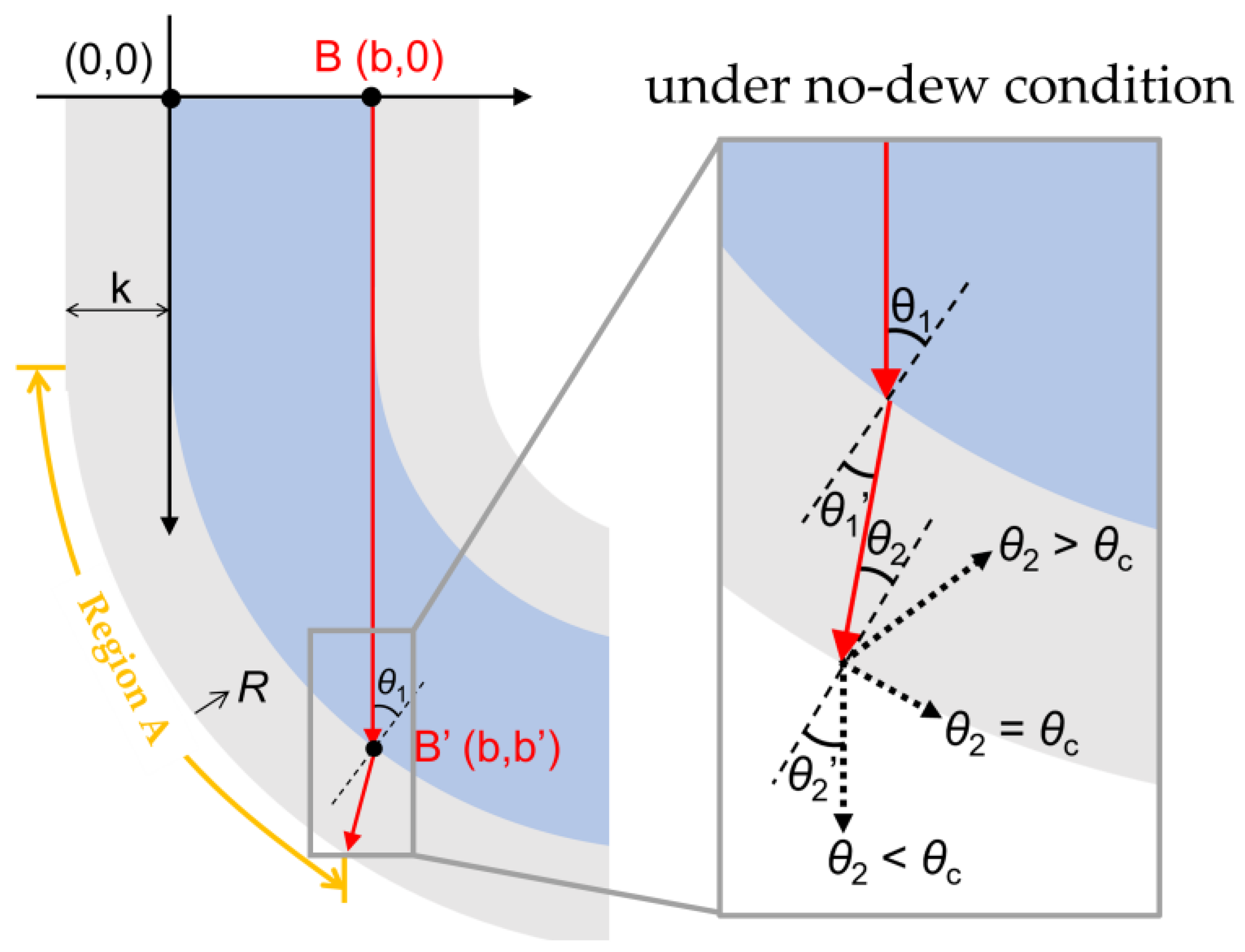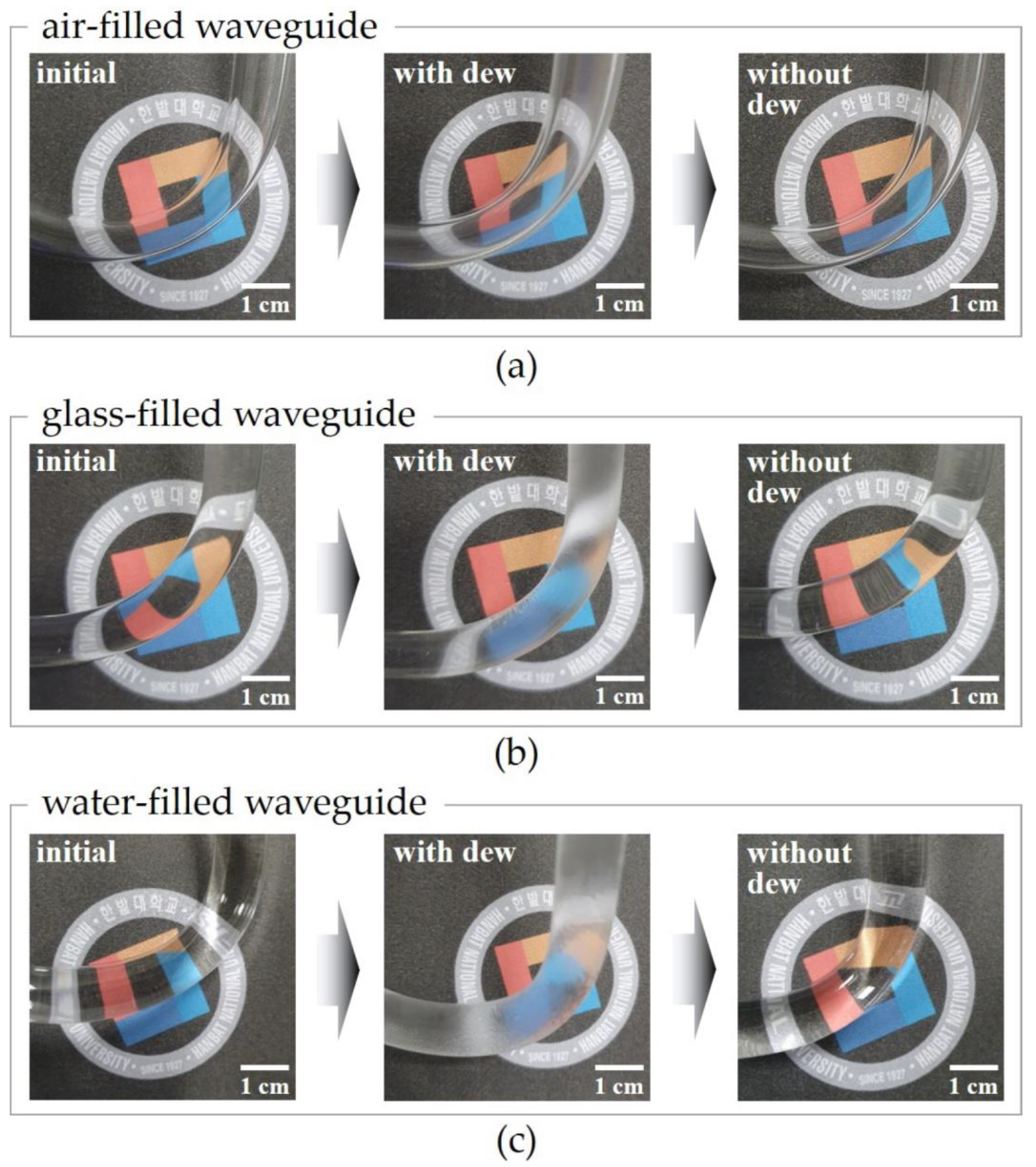A Dew-Condensation Sensor Exploiting Local Variations in the Relative Refractive Index on the Dew-Friendly Surface of a Waveguide
Abstract
1. Introduction
2. Materials and Methods
3. Results and Discussion
3.1. The Basic Structure and Working Principle of the Dew-Condensation Sensor
3.2. The Key Geometric Design for the Dew-Condensation Sensor
3.3. Optical Simulation with Different Filling Materials for the Waveguide
3.4. The Demonstration of Dew-Condensation Detection with the Actual Sensor
3.5. A Repeatability Test of the Actual Sensor with the Water-Filled Waveguide
4. Conclusions
Author Contributions
Funding
Data Availability Statement
Acknowledgments
Conflicts of Interest
References
- Lee, W.S.; Alchanatis, V.; Yang, C.; Hirafuji, M.; Moshou, D.; Li, C. Sensing technologies for precision specialty crop production. Comput. Electron. Agric. 2010, 74, 2–33. [Google Scholar] [CrossRef]
- Mahlein, A.K. Plant disease detection by imaging sensors–parallels and specific demands for precision agriculture and plant phenotyping. Plant Dis. 2016, 100, 241–251. [Google Scholar] [CrossRef] [PubMed]
- Li, S.; Simonian, A. Sensors for agriculture and the food industry. Electrochem. Soc. Interface 2010, 19, 41. [Google Scholar] [CrossRef]
- Baruah, S.; Dutta, J. Nanotechnology applications in pollution sensing and degradation in agriculture: A review. Environ. Chem. Lett. 2009, 7, 191–204. [Google Scholar] [CrossRef]
- Elijah, O.; Rahman, T.A.; Orikumhi, I.; Leow, C.Y.; Hindia, M.N. An overview of Internet of Things (IoT) and data analytics in agriculture: Benefits and challenges. IEEE Internet Things J. 2018, 5, 3758–3773. [Google Scholar] [CrossRef]
- Gago, J.; Douthe, C.; Coopman, R.E.; Gallego, P.P.; Ribas-Carbo, M.; Flexas, J.; Medrano, H. UAVs challenge to assess water stress for sustainable agriculture. Agric. Water Manag. 2015, 153, 9–19. [Google Scholar] [CrossRef]
- Sugiura, R.; Tsuda, S.; Tamiya, S.; Itoh, A.; Nishiwaki, K.; Murakami, N.; Shibuya, Y.; Hirafuji, M.; Nuske, S. Field phenotyping system for the assessment of potato late blight resistance using RGB imagery from an unmanned aerial vehicle. Biosyst. Eng. 2016, 148, 1–10. [Google Scholar] [CrossRef]
- Kim, H.J.; Sudduth, K.A.; Hummel, J.W. Soil macronutrient sensing for precision agriculture. J. Environ. Monit. 2009, 11, 1810–1824. [Google Scholar] [CrossRef]
- Rhee, J.; Im, J.; Carbone, G.J. Monitoring agricultural drought for arid and humid regions using multi-sensor remote sensing data. Remote Sens. Environ. 2010, 114, 2875–2887. [Google Scholar] [CrossRef]
- Campbell, G.S.; Calissendorff, C.; Williams, J.H. Probe for measuring soil specific heat using a heat-pulse method. Soil Sci. Soc. Am. J. 1991, 55, 291–293. [Google Scholar] [CrossRef]
- Ayensu, A. Dehydration of food crops using a solar dryer with convective heat flow. Sol. Energy 1997, 59, 121–126. [Google Scholar] [CrossRef]
- Park, D.H.; Park, J.W. Wireless sensor network-based greenhouse environment monitoring and automatic control system for dew condensation prevention. Sensors 2011, 11, 3640–3651. [Google Scholar] [CrossRef]
- Jayalakshmy, M.S.; Philip, J. Thermophysical properties of plant leaves and their influence on the environment temperature. Int. J. Thermophys. 2010, 31, 2295–2304. [Google Scholar] [CrossRef]
- Agam, N.; Berliner, P.R. Dew formation and water vapor adsorption in semi-arid environments—A review. J. Arid. Environ. 2006, 65, 572–590. [Google Scholar] [CrossRef]
- Baier, W. Studies on dew formation under semi-arid conditions. Agric. Meteorol. 1966, 3, 103–112. [Google Scholar] [CrossRef]
- Lloyd, M.G. The contribution of dew to the summer water budget of northern Idaho. Bull. Am. Meteorol. Soc. 1961, 42, 572–581. [Google Scholar] [CrossRef]
- Pedro, M.J., Jr.; Gillespie, T.J. Estimating dew duration. I. Utilizing micrometeorological data. Agric. Meteorol. 1981, 25, 283–296. [Google Scholar] [CrossRef]
- Farahani, H.; Wagiran, R.; Hamidon, M.N. Humidity sensors principle, mechanism, and fabrication technologies: A comprehensive review. Sensors 2014, 14, 7881–7939. [Google Scholar] [CrossRef]
- Chen, Z.; Lu, C. Humidity sensors: A review of materials and mechanisms. Sens. Lett. 2005, 3, 274–295. [Google Scholar] [CrossRef]
- Rittersma, Z.M. Recent achievements in miniaturised humidity sensors—A review of transduction techniques. Sens. Actuators A Phys. 2002, 96, 196–210. [Google Scholar] [CrossRef]
- Yang, M.; Li, Y.; Zhan, X.; Ling, M. A novel resistive-type humidity sensor based on poly (p-diethynylbenzene). J. Appl. Polym. Sci. 1999, 74, 2010–2015. [Google Scholar] [CrossRef]
- Kim, J.H.; Hong, S.M.; Moon, B.M.; Kim, K. High-performance capacitive humidity sensor with novel electrode and polyimide layer based on MEMS technology. Microsyst. Technol. 2010, 16, 2017–2021. [Google Scholar] [CrossRef]
- Shimizu, Y.; Arai, H.; Seiyama, T. Theoretical studies on the impedance-humidity characteristics of ceramic humidity sensors. Sens. Actuators 1985, 7, 11–22. [Google Scholar] [CrossRef]
- Limodehi, H.E.; Légaré, F. Fiber optic humidity sensor using water vapor condensation. Opt. Express 2017, 25, 15313–15321. [Google Scholar] [CrossRef] [PubMed]
- Limodehi, H.E.; Mozafari, M.; Amiri, H.; Légaré, F. Multi-channel fiber optic dew and humidity sensor. Opt. Fiber Technol. 2018, 41, 89–94. [Google Scholar] [CrossRef]
- Brook, T.E.; Taib, M.N.; Narayanaswamy, R. Extending the range of a fibre-optic relative-humidity. Sensor 1997, 38–39, 272–276. [Google Scholar] [CrossRef]
- Hou, J.; Dai, J.; Zhang, F.; Yang, M. Advanced fiber-optic relative humidity sensor based on graphene quantum dots doped polyimide coating. IEEE Photonics Technol. Lett. 2022, 34, 725–728. [Google Scholar] [CrossRef]
- Huang, P.; Yao, Y.; Zhong, W.; Gu, P.; Yan, Z.; Liu, F.; Yan, B.; Tang, C.; Chen, J.; Zhu, M. Optical sensing based on classical analogy of double Electromagnetically induced transparencies. Results Phys. 2022, 39, 105732. [Google Scholar] [CrossRef]
- Niu, D.; Zerrad, M.; Lereu, A.; Moreau, A.; Lumeau, J.; Zapien, J.A.; Passian, A.; Aubry, V.; Amra, C. Excitation of Bloch Surface Waves in Zero-Admittance Multilayers for High-Sensitivity Sensor Applications. Phys. Rev. Appl. 2020, 13, 054064. [Google Scholar] [CrossRef]
- Sim, E.S.; Hwa, S.B.; Jang, I.H.; Na, J.H.; Kim, M.H. Refractive index-based soil moisture sensor. J. Sens. Sci. Technol. 2021, 30, 415–419. [Google Scholar] [CrossRef]
- Kim, B.-W.; Park, S.-H.; Bandaru, P.R. Anomalous decrease of the specific heat capacity at the electrical and thermal conductivity percolation threshold in nanocomposites. Appl. Phys. Lett. 2014, 105, 253108. [Google Scholar] [CrossRef]
- Zaharov, V.V.; Farahi, R.H.; Snyder, P.J.; Davison, B.H.; Passian, A. Karhunen-Loève treatment to remove noise and facilitate data analysis in sensing, spectroscopy and other applications. Analyst 2014, 139, 5927–5935. [Google Scholar] [CrossRef]







Disclaimer/Publisher’s Note: The statements, opinions and data contained in all publications are solely those of the individual author(s) and contributor(s) and not of MDPI and/or the editor(s). MDPI and/or the editor(s) disclaim responsibility for any injury to people or property resulting from any ideas, methods, instructions or products referred to in the content. |
© 2023 by the authors. Licensee MDPI, Basel, Switzerland. This article is an open access article distributed under the terms and conditions of the Creative Commons Attribution (CC BY) license (https://creativecommons.org/licenses/by/4.0/).
Share and Cite
Hwa, S.; Sim, E.-S.; Na, J.-H.; Jang, I.-H.; Kwon, J.-H.; Kim, M.-H. A Dew-Condensation Sensor Exploiting Local Variations in the Relative Refractive Index on the Dew-Friendly Surface of a Waveguide. Sensors 2023, 23, 2857. https://doi.org/10.3390/s23052857
Hwa S, Sim E-S, Na J-H, Jang I-H, Kwon J-H, Kim M-H. A Dew-Condensation Sensor Exploiting Local Variations in the Relative Refractive Index on the Dew-Friendly Surface of a Waveguide. Sensors. 2023; 23(5):2857. https://doi.org/10.3390/s23052857
Chicago/Turabian StyleHwa, Subin, Eun-Seon Sim, Jun-Hee Na, Ik-Hoon Jang, Jin-Hyuk Kwon, and Min-Hoi Kim. 2023. "A Dew-Condensation Sensor Exploiting Local Variations in the Relative Refractive Index on the Dew-Friendly Surface of a Waveguide" Sensors 23, no. 5: 2857. https://doi.org/10.3390/s23052857
APA StyleHwa, S., Sim, E.-S., Na, J.-H., Jang, I.-H., Kwon, J.-H., & Kim, M.-H. (2023). A Dew-Condensation Sensor Exploiting Local Variations in the Relative Refractive Index on the Dew-Friendly Surface of a Waveguide. Sensors, 23(5), 2857. https://doi.org/10.3390/s23052857






